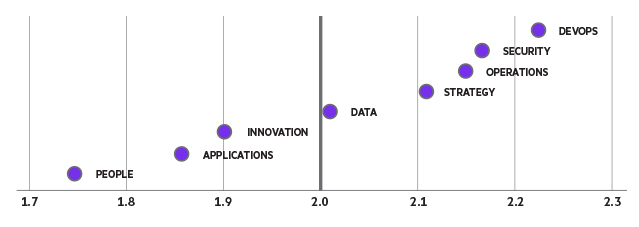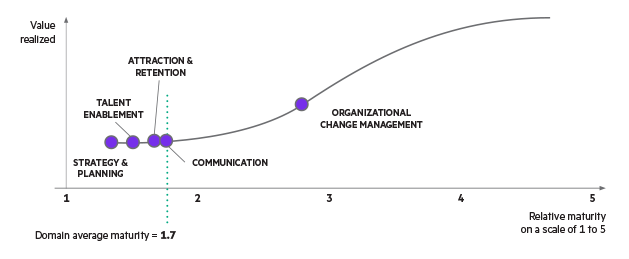Tech
Investing in people is key to successful transformation
Published
3 years agoon
By
Drew Simpson
People can be your most important catalyst for digital transformation—or the greatest obstacle. When people-related challenges to transformation progress emerge, the problems are usually very easy to identify but much harder to solve.
The challenge is not awareness. Organizations realize that cloud transformations are hard and that they need highly skilled, motivated staff to carry out the projects. But they still struggle to build out the processes to create those staffs and, as a result, hit other project-focused goals.
“By celebrating accomplishments and innovation frequently, you reinforce role-model behavior and develop grassroots momentum for change initiatives.”
Where things stand
Based on our engagements with customers, we’ve evaluated enterprise progress in capability in the eight domains making up the HPE Edge to Cloud Adoption Framework.
The People domain is the one in which organizations struggle the most to make progress, with an average maturity of 1.7 on a scale of 1 to 5, where a score of 3 indicates a cloud-ready organization (see Figure 1).
That’s not to say they’re bad employers. They can value employees themselves and aspire to raise their overall talent level but still fall short in the overall delivery of talent-related initiatives. They can create talent development plans but fail to align them to cloud-focused initiatives. And they can pledge to do a better job building a talent base but fail to exercise the organizational muscle to make it happen.
The struggles cloud-focused organizations have on the people front can be tracked to four of these factors (see Figure 2):
- Talent attraction and retention
- Talent enablement
- Communication
- Strategy and planning

While most organizations at least try to address each of these factors, many don’t have the deliberate plans needed to drive complicated cloud transformations.
A methodical approach to identifying well-defined initiatives that can be implemented in measurable increments can go a long way toward addressing people-related obstacles to transformation progress.
Attract and retain: Competing for specialized skills
Start with attracting and retaining talent. In today’s competitive IT environments, it’s critical for organizations to attract the specialized skills they need. Every company is competing for the same hybrid, public cloud, and edge talent. But organizations are struggling with traditional onboarding techniques. Job searches and exec searches often don’t reach people with the right skills. Compensation packages are getting expensive. Geographical requirements are often too rigid.
Across the population of organizations we engage with, those that are lagging in cloud maturity simply aren’t effective at acquiring the talent needed to do the job, and they’re not extending internal plans to retain the talent they have.
In contrast, leaders on the people front are developing systems to find this talent and sustain it. They have a solid foundation for performance and talent management already in place, and they’re adapting it to meet the needs of new areas like hybrid cloud security, hybrid networking, and internet of things. Culture, salary competitiveness, and nonmonetary incentives play a large part in how effective an organization is at talent identification and recruitment success.
Leading organizations are defining new job functions and new practice areas, where exciting growth opportunities can be used to compete for attention. They are attracting talent outside of the traditional full-time equivalent roles by developing strategic relationships for contractors, partners, and other non-FTE workers.

An insurance company we worked with built a program to establish comprehensive insights on skills and proficiencies across the enterprise that allowed it to develop a risk and succession plan and target selective areas in which to acquire public cloud skills externally.
Talent enablement: Modernize training to accelerate upskilling
Once the workforce is in place, organizations need to put plans in place to sharpen skills in important areas across IT—everything from security to infrastructure to application development. Legacy shops usually rely on passive learning techniques like courses, webinars, and prerecorded trainings. But they often have incomplete course catalogs because skills in hybrid cloud and the edge are rapidly evolving. That means they don’t have the offerings available to train up people.
The leading organizations in our customer population generate better results by creating learning journeys focused on more measurable, active learning measures. Coaching and mentoring is a long-standing practice that builds confidence in organizations bringing on new sets of tasks, platforms, and responsibilities. They’re installing job rotations within roles and contexts.
They’re also conducting so-called two-in-a-box techniques whereby experts are brought in from an outside partner to work alongside staff. These extra hands deliver services while also training up staffers to handle tasks related to a new cloud initiative—essentially catching fish while helping the workers learn to catch their own. A top five US bank we worked with employed this approach, emphasizing active learning techniques and modern learner experiences.
Communications: Leading and communicating through change
We find significant variation in communications capability across our customer population, which impacts transformation effectiveness.
Transformations affect workers in different ways. Organizations that display maturity in this capability are using new platforms, performing new jobs, working new schedules, and often reporting within newly configured team structures.
Where we see issues with communications, organizations are often doing a poor job of explaining the new landscape and helping workers adjust to new expectations. Commitment by leadership to build awareness and a meaningful understanding of changes being made will help prepare and enable staff for the next phases of the transformation journey.
Organizations with effective communications strategies understand that it’s important to use communications not merely as a mechanism to update people about changes but also to celebrate individual and team accomplishments. This can be done through internal channels like collaborative communications platforms, newsletters, and internal recognitions. It also helps to leverage external channels like social media and LinkedIn to circulate successes.
By celebrating accomplishments and innovation frequently, you reinforce role-model behavior and develop grassroots momentum for change initiatives.
Strategy and planning: Manage risk and create flexibility through succession planning
Despite all the work organizations do to retain employees with roles that are critical to transformation success, employees still leave. They may be making personal choices that have nothing to do with their commitments to their company. So, what happens if one key director or a group of critically important programmers choose to take other jobs? Does the company’s transformation suffer?
Among our customer population, leaders and laggards differ significantly in how they conduct succession planning. Laggards don’t understand the risk associated with their human capital, and they’re often not building out succession plans to absorb exits from critical IT roles. And by not having this plan, business and IT operations can be disrupted.
The first step in addressing this situation is making sure you understand the skills and competencies you have across your organizations. Prepare a risk assessment that evaluates the impact on operational and business continuity if someone important leaves. From the risk assessment, you can build out a succession plan and install cross-training plans to ensure that skill levels in critical areas are backed up within the organization.
Leaders often go a step further. Advanced organizations with highly functioning talent plans have a keen awareness of where these critical roles lie within new practice areas. They set up mechanisms to identify and reward high performers in these critical areas.
You may like
-


People shouldn’t pay such a high price for calling out AI harms
-


Three people were gene-edited in an effort to cure their HIV. The result is unknown.
-
Seeking a successful path to core modernization
-


Oyster fight: The humble sea creature could hold the key to restoring coastal waters. Developers hate it.
-


A Successful Digital Transformation Starts (and Ends) With People
-


Elon Musk wants more bandwidth between people and machines. Do we need it?
Tech
The hunter-gatherer groups at the heart of a microbiome gold rush
Published
5 months agoon
12/19/2023By
Drew Simpson
The first step to finding out is to catalogue what microbes we might have lost. To get as close to ancient microbiomes as possible, microbiologists have begun studying multiple Indigenous groups. Two have received the most attention: the Yanomami of the Amazon rainforest and the Hadza, in northern Tanzania.
Researchers have made some startling discoveries already. A study by Sonnenburg and his colleagues, published in July, found that the gut microbiomes of the Hadza appear to include bugs that aren’t seen elsewhere—around 20% of the microbe genomes identified had not been recorded in a global catalogue of over 200,000 such genomes. The researchers found 8.4 million protein families in the guts of the 167 Hadza people they studied. Over half of them had not previously been identified in the human gut.
Plenty of other studies published in the last decade or so have helped build a picture of how the diets and lifestyles of hunter-gatherer societies influence the microbiome, and scientists have speculated on what this means for those living in more industrialized societies. But these revelations have come at a price.
A changing way of life
The Hadza people hunt wild animals and forage for fruit and honey. “We still live the ancient way of life, with arrows and old knives,” says Mangola, who works with the Olanakwe Community Fund to support education and economic projects for the Hadza. Hunters seek out food in the bush, which might include baboons, vervet monkeys, guinea fowl, kudu, porcupines, or dik-dik. Gatherers collect fruits, vegetables, and honey.
Mangola, who has met with multiple scientists over the years and participated in many research projects, has witnessed firsthand the impact of such research on his community. Much of it has been positive. But not all researchers act thoughtfully and ethically, he says, and some have exploited or harmed the community.
One enduring problem, says Mangola, is that scientists have tended to come and study the Hadza without properly explaining their research or their results. They arrive from Europe or the US, accompanied by guides, and collect feces, blood, hair, and other biological samples. Often, the people giving up these samples don’t know what they will be used for, says Mangola. Scientists get their results and publish them without returning to share them. “You tell the world [what you’ve discovered]—why can’t you come back to Tanzania to tell the Hadza?” asks Mangola. “It would bring meaning and excitement to the community,” he says.
Some scientists have talked about the Hadza as if they were living fossils, says Alyssa Crittenden, a nutritional anthropologist and biologist at the University of Nevada in Las Vegas, who has been studying and working with the Hadza for the last two decades.
The Hadza have been described as being “locked in time,” she adds, but characterizations like that don’t reflect reality. She has made many trips to Tanzania and seen for herself how life has changed. Tourists flock to the region. Roads have been built. Charities have helped the Hadza secure land rights. Mangola went abroad for his education: he has a law degree and a master’s from the Indigenous Peoples Law and Policy program at the University of Arizona.
Tech
The Download: a microbiome gold rush, and Eric Schmidt’s election misinformation plan
Published
5 months agoon
12/18/2023By
Drew Simpson
Over the last couple of decades, scientists have come to realize just how important the microbes that crawl all over us are to our health. But some believe our microbiomes are in crisis—casualties of an increasingly sanitized way of life. Disturbances in the collections of microbes we host have been associated with a whole host of diseases, ranging from arthritis to Alzheimer’s.
Some might not be completely gone, though. Scientists believe many might still be hiding inside the intestines of people who don’t live in the polluted, processed environment that most of the rest of us share. They’ve been studying the feces of people like the Yanomami, an Indigenous group in the Amazon, who appear to still have some of the microbes that other people have lost.
But there is a major catch: we don’t know whether those in hunter-gatherer societies really do have “healthier” microbiomes—and if they do, whether the benefits could be shared with others. At the same time, members of the communities being studied are concerned about the risk of what’s called biopiracy—taking natural resources from poorer countries for the benefit of wealthier ones. Read the full story.
—Jessica Hamzelou
Eric Schmidt has a 6-point plan for fighting election misinformation
—by Eric Schmidt, formerly the CEO of Google, and current cofounder of philanthropic initiative Schmidt Futures
The coming year will be one of seismic political shifts. Over 4 billion people will head to the polls in countries including the United States, Taiwan, India, and Indonesia, making 2024 the biggest election year in history.
Tech
Navigating a shifting customer-engagement landscape with generative AI
Published
5 months agoon
12/18/2023By
Drew Simpson
A strategic imperative
Generative AI’s ability to harness customer data in a highly sophisticated manner means enterprises are accelerating plans to invest in and leverage the technology’s capabilities. In a study titled “The Future of Enterprise Data & AI,” Corinium Intelligence and WNS Triange surveyed 100 global C-suite leaders and decision-makers specializing in AI, analytics, and data. Seventy-six percent of the respondents said that their organizations are already using or planning to use generative AI.
According to McKinsey, while generative AI will affect most business functions, “four of them will likely account for 75% of the total annual value it can deliver.” Among these are marketing and sales and customer operations. Yet, despite the technology’s benefits, many leaders are unsure about the right approach to take and mindful of the risks associated with large investments.
Mapping out a generative AI pathway
One of the first challenges organizations need to overcome is senior leadership alignment. “You need the necessary strategy; you need the ability to have the necessary buy-in of people,” says Ayer. “You need to make sure that you’ve got the right use case and business case for each one of them.” In other words, a clearly defined roadmap and precise business objectives are as crucial as understanding whether a process is amenable to the use of generative AI.
The implementation of a generative AI strategy can take time. According to Ayer, business leaders should maintain a realistic perspective on the duration required for formulating a strategy, conduct necessary training across various teams and functions, and identify the areas of value addition. And for any generative AI deployment to work seamlessly, the right data ecosystems must be in place.
Ayer cites WNS Triange’s collaboration with an insurer to create a claims process by leveraging generative AI. Thanks to the new technology, the insurer can immediately assess the severity of a vehicle’s damage from an accident and make a claims recommendation based on the unstructured data provided by the client. “Because this can be immediately assessed by a surveyor and they can reach a recommendation quickly, this instantly improves the insurer’s ability to satisfy their policyholders and reduce the claims processing time,” Ayer explains.
All that, however, would not be possible without data on past claims history, repair costs, transaction data, and other necessary data sets to extract clear value from generative AI analysis. “Be very clear about data sufficiency. Don’t jump into a program where eventually you realize you don’t have the necessary data,” Ayer says.
The benefits of third-party experience
Enterprises are increasingly aware that they must embrace generative AI, but knowing where to begin is another thing. “You start off wanting to make sure you don’t repeat mistakes other people have made,” says Ayer. An external provider can help organizations avoid those mistakes and leverage best practices and frameworks for testing and defining explainability and benchmarks for return on investment (ROI).
Using pre-built solutions by external partners can expedite time to market and increase a generative AI program’s value. These solutions can harness pre-built industry-specific generative AI platforms to accelerate deployment. “Generative AI programs can be extremely complicated,” Ayer points out. “There are a lot of infrastructure requirements, touch points with customers, and internal regulations. Organizations will also have to consider using pre-built solutions to accelerate speed to value. Third-party service providers bring the expertise of having an integrated approach to all these elements.”
